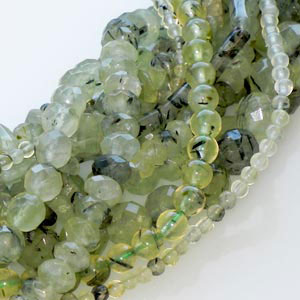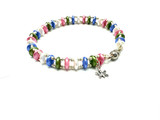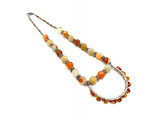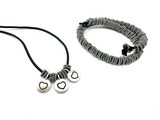Gemstone Index: Prehnite
 This pale green stone has the distinction of being the first mineral named after a person. In the mid-18th century, Dutch mineralogist Colonel Hendrik Von Prehn (1733-1785) discovered it within Jurassic dolerite (volcanic rock) on the Cape of Good Hope, South Africa. For many years, prehnite was regarded as a fairly rare gemstone. However, recent finds in Australia and China have made it available through many gem dealers. Prehnite is a hydrous silicate of alumina and lime, with bright, almost luminescent green coloring. It forms thick crusts with a rough or crystalline texture, and is commonly found in cavities and "pillows" along fractures of basalt. Usually ranging from pale to grass green, prehnite can also be gray, white, black, brown or colorless. Its luster is vitreous to waxy, or pearly, and its crystals are transparent to mostly translucent. Prehnite is very long-wearing and durable gemstone. When it features inclusions of black amphabole, as most of our beads do, it is easily confused with green tourmalated quartz.
This pale green stone has the distinction of being the first mineral named after a person. In the mid-18th century, Dutch mineralogist Colonel Hendrik Von Prehn (1733-1785) discovered it within Jurassic dolerite (volcanic rock) on the Cape of Good Hope, South Africa. For many years, prehnite was regarded as a fairly rare gemstone. However, recent finds in Australia and China have made it available through many gem dealers. Prehnite is a hydrous silicate of alumina and lime, with bright, almost luminescent green coloring. It forms thick crusts with a rough or crystalline texture, and is commonly found in cavities and "pillows" along fractures of basalt. Usually ranging from pale to grass green, prehnite can also be gray, white, black, brown or colorless. Its luster is vitreous to waxy, or pearly, and its crystals are transparent to mostly translucent. Prehnite is very long-wearing and durable gemstone. When it features inclusions of black amphabole, as most of our beads do, it is easily confused with green tourmalated quartz.Prehnite is often found with zeolites and is sometimes considered a zeolite, but the two stones are from different geologic classes. However, like zeolites, prehnite can give off water when heated, but cannot gain the water back. Minerals confused with prehnite include gyrolite, smithsonite and hemimorphite. Prehnite is harder than all of these and lacks smithsonite's unusual luster. Hemimorphite is often blue, and gyrolite is not as glassy.
Once Von Prehn had returned to Europe with his specimens, mineral collector Balthazar Sage became the first to describe the stone. In a 1777 writing, Sage referred to the new mineral as "chrysotile." The earliest illustration of prehnite is probably the excellent hand-colored plate in the minerology work Gautier d'Agoty's Histoire Naturelle Regne Mineral, produced around 1789. There, the stone is labeled Chorle vert, du Cap de Bonne Esperance ("Green schorl from the Cape of Good Hope"). 1789 was also the year in which German geologist Abraham Werner named the species prehnite after Von Prehn, setting a nomenclatural precedent that endures to this day.
Known as the "prediction stone" among spiritual healers, prehnite is believed to enhance one's protective field, dreaming and remembrance. Crystal healers use the stone to reduce high blood pressure and control hypertension, as it is believed prehnite's color and unusual touch generate serenity and tranquility. It is also thought to build the immune system and treat blood disorders. Notable occurrences of prehnite include Mali, the Cape of Good Hope, South Africa, the U.S.A. (Connecticut, Pennsylvania, New Jersey and Virginia), India, Germany, Austria, Scotland, Namibia, Canada, China, New South Wales, Australia and France.
Our Bead Blog
-
Simply Springy 2-Hole Bracelet
Apr 28th 2025Designed by: Guest Designer Deb Floros Suggested Supplies 1 #61-840-50-01 Beadalon Cord, WildFire,
-
Exotic Statement Necklace
Apr 28th 2025Designed by: Guest Designer Deb Floros Suggested Supplies 1 #88-400-003-5 58x50mm Pewter Connector,
-
Rubber Tubing Necklace and Memory Wire Bracelet Set
Mar 21st 2025Designed by: Guest Designer Deb Floros Suggested Supplies 1 #61-622-02 2mm Rubber Cord, Bulk, for J




